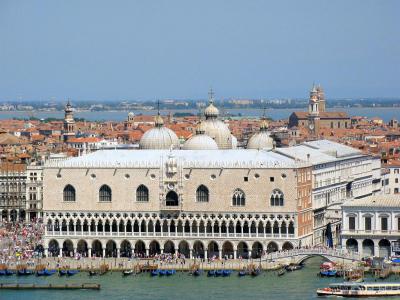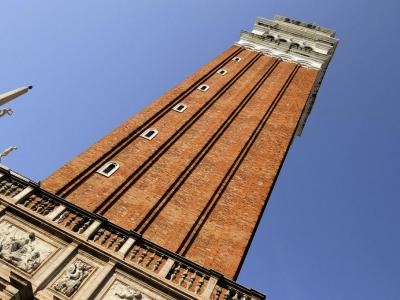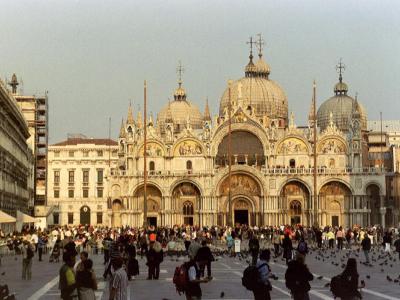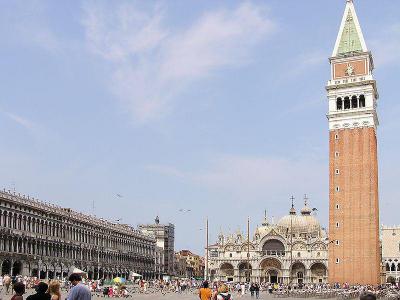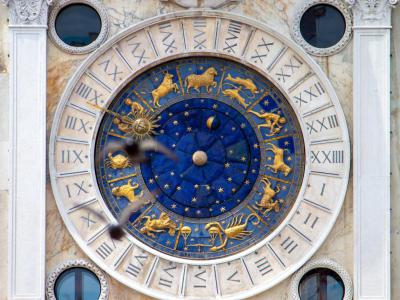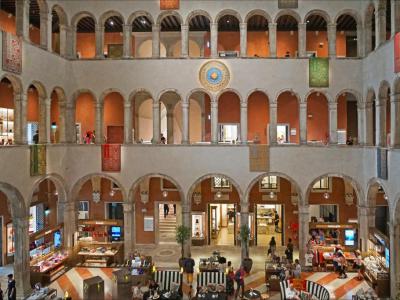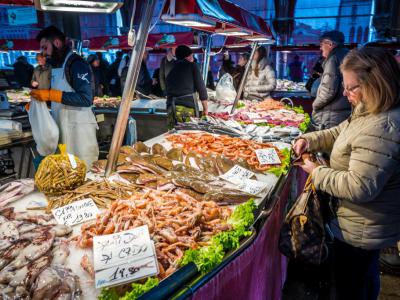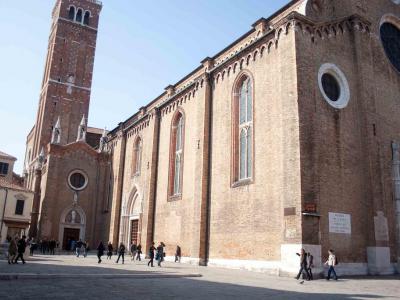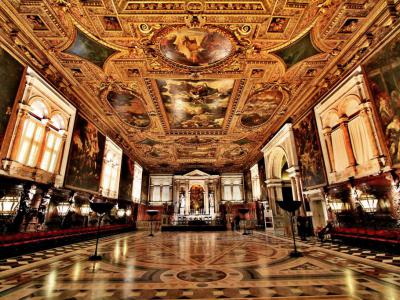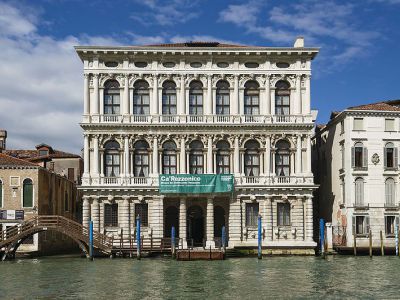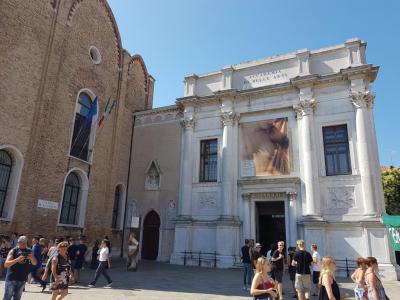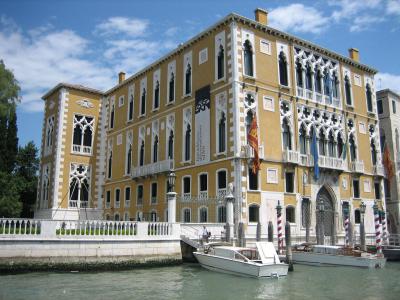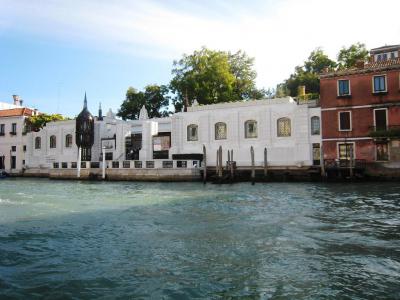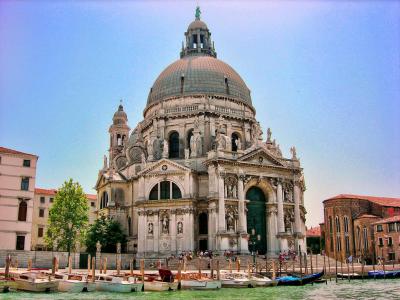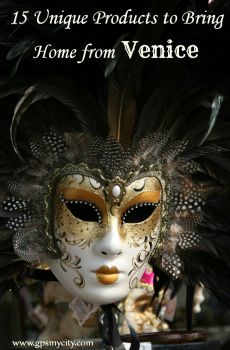Venice Introduction Walking Tour (Self Guided), Venice
Although most experts agree that the Venetian lagoon emerged nearly 6,000 years ago, the area of today's Venice remained mostly uninhabited, except for a small population of fishermen, up until the 5th century AD when the hordes of Gothic barbarians, looting their way into Rome, drove many a people away from their homes on the mainland to take refuge on the coastal Venetian islands.
Those who fled the burning and plundering by the invaders founded a city which was officially recognized as such after the remains of St. Mark the Evangelist, brought from Alexandria, Egypt, were interred here some time around the 9th century AD. At that point, St. Mark became the patron of Venice and made it part of the Christian world.
Shortly afterwards, Venice had gained independence from the Byzantine Empire and, by the early 11th century, emerged as a powerful city-state successfully trading with the Christian forces during the Crusades. Two centuries later, Venice became a seasoned maritime republic, reigning supreme over the Mediterranean, stifling opposition from the Byzantine Empire.
The Venetian Republic was ruled by a Doge, an elected for life leader assisted by the Council of 10 and the Grand Council of 2,000 members. This form of government remained in force until the Napoleonic invasion of 1797 removed the Venetian Doge and Grand Council from power, thus marking the end of the Republic.
The ensued period of decline lasted until the turn of the 19th century when Venice emerged on the scene once again, this time as a fashionable vacation spot for the wealthy.
Reputed as one of the most romantic places ever built by man, Venice is nicknamed “the City of Water” and “the City of Bridges”. Other than the water and bridges though, the city boasts great art legacy manifested in numerous palaces, galleries, and churches of unparalleled beauty.
The Venice Introduction Walk takes you to the top landmarks of Venice, most of which located along the Grand Canal and San Marco quarter.
Getting to Sight #1. The first tour stop (Palazzo Ducale (Doge's Palace)) is on San Marco Square or can be reached by: Alilaguna Water Taxi: Blue (B), Rosa (R); Water Bus: 1, 2, 4.1, 10, 7, 4.2, 5.2, 2, 20 + N (Night line).
Those who fled the burning and plundering by the invaders founded a city which was officially recognized as such after the remains of St. Mark the Evangelist, brought from Alexandria, Egypt, were interred here some time around the 9th century AD. At that point, St. Mark became the patron of Venice and made it part of the Christian world.
Shortly afterwards, Venice had gained independence from the Byzantine Empire and, by the early 11th century, emerged as a powerful city-state successfully trading with the Christian forces during the Crusades. Two centuries later, Venice became a seasoned maritime republic, reigning supreme over the Mediterranean, stifling opposition from the Byzantine Empire.
The Venetian Republic was ruled by a Doge, an elected for life leader assisted by the Council of 10 and the Grand Council of 2,000 members. This form of government remained in force until the Napoleonic invasion of 1797 removed the Venetian Doge and Grand Council from power, thus marking the end of the Republic.
The ensued period of decline lasted until the turn of the 19th century when Venice emerged on the scene once again, this time as a fashionable vacation spot for the wealthy.
Reputed as one of the most romantic places ever built by man, Venice is nicknamed “the City of Water” and “the City of Bridges”. Other than the water and bridges though, the city boasts great art legacy manifested in numerous palaces, galleries, and churches of unparalleled beauty.
The Venice Introduction Walk takes you to the top landmarks of Venice, most of which located along the Grand Canal and San Marco quarter.
Getting to Sight #1. The first tour stop (Palazzo Ducale (Doge's Palace)) is on San Marco Square or can be reached by: Alilaguna Water Taxi: Blue (B), Rosa (R); Water Bus: 1, 2, 4.1, 10, 7, 4.2, 5.2, 2, 20 + N (Night line).
How it works: Download the app "GPSmyCity: Walks in 1K+ Cities" from Apple App Store or Google Play Store to your mobile phone or tablet. The app turns your mobile device into a personal tour guide and its built-in GPS navigation functions guide you from one tour stop to next. The app works offline, so no data plan is needed when traveling abroad.
Venice Introduction Walking Tour Map
Guide Name: Venice Introduction Walking Tour
Guide Location: Italy » Venice (See other walking tours in Venice)
Guide Type: Self-guided Walking Tour (Sightseeing)
# of Attractions: 16
Tour Duration: 3 Hour(s)
Travel Distance: 4.1 Km or 2.5 Miles
Author: greghasleft
Sight(s) Featured in This Guide:
Guide Location: Italy » Venice (See other walking tours in Venice)
Guide Type: Self-guided Walking Tour (Sightseeing)
# of Attractions: 16
Tour Duration: 3 Hour(s)
Travel Distance: 4.1 Km or 2.5 Miles
Author: greghasleft
Sight(s) Featured in This Guide:
- Palazzo Ducale (Doge's Palace)
- Campanile di San Marco (St. Mark's Bell Tower)
- Basilica di San Marco (St. Mark's Basilica)
- Piazza San Marco (St. Mark's Square)
- Torre dell'Orologio (Clock Tower)
- Fondaco dei Tedeschi (Shopping, Art and Culture)
- Ponte di Rialto (Rialto Bridge)
- Mercato di Rialto (Rialto Food Market)
- Basilica di Santa Maria Gloriosa dei Frari (Basilica of Glorious St. Mary of the Friars)
- Scuola Grande di San Rocco (Great School of St. Roch)
- Campo Santa Margherita (St. Margaret's Square)
- Ca' Rezzonico – Museum of 18th-century Venice
- Gallerie dell'Accademia (Gallery of the Academy)
- Palazzo Cavalli-Franchetti (Cavalli-Franchetti Palace)
- Peggy Guggenheim Collection
- Basilica di Santa Maria della Salute (Basilica of Our Lady of Good Health)
1) Palazzo Ducale (Doge's Palace) (must see)
Built on the foundations of a 9th-century fortress, this palace is unquestionably the finest secular European building of its time. Over the course of centuries, it has served many purposes, including Doge residence, seat of the Venetian government, court of law, civil office, and even a prison.
First built in the 14th century, much of the edifice was destroyed by fire in the 16th century, reducing to ashes most of the art treasures held inside. Some of the greatest Venetian masters of the time, such as Tintoretto, Veronese, Titian, Bellini, and Tiepolo, contributed to the restoration efforts, recreating gilded stucco, sculptures, frescoes, and canvases that returned the palace to its former glory.
Externally, the palace exhibits a blend of Byzantine and Gothic architectural styles, while the interior exudes Classical elements, leading art critic John Ruskin to proclaim it "the central building of the world". Inside, visitors are treated to a lavish display of furnishings, paintings, and elaborately adorned ceilings. Of notable grandeur is the Grand Council chamber, featuring Tintoretto's monumental "Paradise", reputedly the largest oil painting in the world. Equally magnificent is the Sala dello Scrutinio, or "Voting Hall," adorned with paintings depicting Venice's glorious past.
In stark contrast, the opposite side of the canal reveals the grim remnants of medieval justice-the prison cells. Linked to the outside world by the Bridge of Sighs ("Ponte dei Sospiri"), these cells serve as a haunting reminder of the horrors endured by prisoners who faced torture and potential death at the hands of the city's appointed state inquisitors. The term "sighs" refers to the lamentations of countless victims forced across the bridge.
To get the most of your time at the Doge's Palace, consider using the infrared audio guide available at the entrance, which provides a captivating narrative of the 1,000-year-old maritime republic of Venice and the intricacies of its former government.
***CASANOVA TOUR***
At the age of 30, on the fateful night of 25 July 1755, Casanova found himself arrested, accused of offending religion and common decency. Shockingly, he was sentenced to five years of imprisonment without even being granted a trial. His confinement took place in the Doge's Palace, where he was confined to a cell beneath the lead-covered roof. In the sweltering summer months, the oppressive heat turned his place of incarceration into an unbearable oven, further exacerbated by the torment of countless fleas infesting the premises.
Physically, Casanova was not far from the opulence of Venice and the seat of power, yet the psychological distance between his confinement and the world outside was immeasurable. Enduring 15 months of torment and despair, he finally hatched a daring plan to escape. Creating a hole in the ceiling, he ingeniously fashioned ropes from bed sheets and descended to freedom. This remarkable escape made Casanova the only person ever to break free from the prison of the Doge's Palace. Seeking sanctuary, he first sought refuge in Munich, then continued his journey to Strasbourg, eventually concluding his odyssey by coach to Paris, where he would start a new life.
Tip:
Make sure to book in advance for the guided "Secret Itinerary" tour – an exclusive experience grants access to otherwise restricted quarters and hidden passageways, including the Doge's private chambers, the interrogation rooms where prisoners were questioned, and the two cells once occupied by Casanova.
First built in the 14th century, much of the edifice was destroyed by fire in the 16th century, reducing to ashes most of the art treasures held inside. Some of the greatest Venetian masters of the time, such as Tintoretto, Veronese, Titian, Bellini, and Tiepolo, contributed to the restoration efforts, recreating gilded stucco, sculptures, frescoes, and canvases that returned the palace to its former glory.
Externally, the palace exhibits a blend of Byzantine and Gothic architectural styles, while the interior exudes Classical elements, leading art critic John Ruskin to proclaim it "the central building of the world". Inside, visitors are treated to a lavish display of furnishings, paintings, and elaborately adorned ceilings. Of notable grandeur is the Grand Council chamber, featuring Tintoretto's monumental "Paradise", reputedly the largest oil painting in the world. Equally magnificent is the Sala dello Scrutinio, or "Voting Hall," adorned with paintings depicting Venice's glorious past.
In stark contrast, the opposite side of the canal reveals the grim remnants of medieval justice-the prison cells. Linked to the outside world by the Bridge of Sighs ("Ponte dei Sospiri"), these cells serve as a haunting reminder of the horrors endured by prisoners who faced torture and potential death at the hands of the city's appointed state inquisitors. The term "sighs" refers to the lamentations of countless victims forced across the bridge.
To get the most of your time at the Doge's Palace, consider using the infrared audio guide available at the entrance, which provides a captivating narrative of the 1,000-year-old maritime republic of Venice and the intricacies of its former government.
***CASANOVA TOUR***
At the age of 30, on the fateful night of 25 July 1755, Casanova found himself arrested, accused of offending religion and common decency. Shockingly, he was sentenced to five years of imprisonment without even being granted a trial. His confinement took place in the Doge's Palace, where he was confined to a cell beneath the lead-covered roof. In the sweltering summer months, the oppressive heat turned his place of incarceration into an unbearable oven, further exacerbated by the torment of countless fleas infesting the premises.
Physically, Casanova was not far from the opulence of Venice and the seat of power, yet the psychological distance between his confinement and the world outside was immeasurable. Enduring 15 months of torment and despair, he finally hatched a daring plan to escape. Creating a hole in the ceiling, he ingeniously fashioned ropes from bed sheets and descended to freedom. This remarkable escape made Casanova the only person ever to break free from the prison of the Doge's Palace. Seeking sanctuary, he first sought refuge in Munich, then continued his journey to Strasbourg, eventually concluding his odyssey by coach to Paris, where he would start a new life.
Tip:
Make sure to book in advance for the guided "Secret Itinerary" tour – an exclusive experience grants access to otherwise restricted quarters and hidden passageways, including the Doge's private chambers, the interrogation rooms where prisoners were questioned, and the two cells once occupied by Casanova.
2) Campanile di San Marco (St. Mark's Bell Tower)
Venice's tallest bell tower was originally constructed in the 12th century. It served as a combined lighthouse and belfry and underwent continuous modifications until the 16th century when the golden angel was installed on its summit. Back in the day, each of the five bells served a specific purpose: the largest tolled to mark the beginning and end of the workday, another rang at midday, two others announced sessions of the Senate or called members of the Grand Council to meetings, and the smallest signaled an impending execution.
It was from the top of this belfry that Galileo Galilei famously showcased his telescope to the Venetian Doge in 1609 – a significant event commemorated by a plaque at the tower's observation deck. Still, the most dramatic episode associated with the Campanile occurred on July 14, 1902, when the tower collapsed shortly after giving a warning sound, causing the leisurely coffee drinkers below in the piazza to flee for their lives.
The Venetians put the Campanile back "where it was and how it was", and the tower is now safe to ascend all the way to the top. Unlike other belfries that require navigating narrow, steep spiral staircases, the Venetian one has an elevator allowing to effortlessly enjoy a pigeon's-eye view for a fee.
Rising 99 meters (325 feet) in height, the Campanile stands as the tallest structure in Venice, providing an ideal vantage point to admire the domes of Saint Mark's Basilica ("Basilica San Marco") and the surrounding lagoon. In the evenings, when the view is exceptionally clear, one can even observe distant landscapes for miles. However, even from the base of this historic bell tower, gazing up at its summit can be an equally thrilling experience.
It was from the top of this belfry that Galileo Galilei famously showcased his telescope to the Venetian Doge in 1609 – a significant event commemorated by a plaque at the tower's observation deck. Still, the most dramatic episode associated with the Campanile occurred on July 14, 1902, when the tower collapsed shortly after giving a warning sound, causing the leisurely coffee drinkers below in the piazza to flee for their lives.
The Venetians put the Campanile back "where it was and how it was", and the tower is now safe to ascend all the way to the top. Unlike other belfries that require navigating narrow, steep spiral staircases, the Venetian one has an elevator allowing to effortlessly enjoy a pigeon's-eye view for a fee.
Rising 99 meters (325 feet) in height, the Campanile stands as the tallest structure in Venice, providing an ideal vantage point to admire the domes of Saint Mark's Basilica ("Basilica San Marco") and the surrounding lagoon. In the evenings, when the view is exceptionally clear, one can even observe distant landscapes for miles. However, even from the base of this historic bell tower, gazing up at its summit can be an equally thrilling experience.
3) Basilica di San Marco (St. Mark's Basilica) (must see)
By far, the main draw for tourists visiting Venice is Saint Mark's Basilica. Its construction dates back to 832 AD when it was built to house the remains of Saint Mark, the city's patron saint. Legend has it that the holy man's body was brought from Alexandria, Egypt, hidden in barrels of pork meat, which the Venetian merchants believed the Muslim guards would never touch. Upon arrival in the lagoon, Saint Mark was said to be greeted by an angel who proclaimed that his body would find rest in that place. This legend has inspired numerous works of art throughout the centuries.
Two hundred years later, a magnificent temple was erected on the foundations of an earlier church and consecrated when Saint Mark's body was laid to rest beneath the high altar. The new basilica was designed after the renowned Church of the Apostles in Constantinople. To enhance its splendor, the structure was adorned with marble and mosaics depicting scenes from the Old and New Testaments, as well as the lives of Christ, the Virgin Mary, and Saint Mark himself.
Over time, many of the mosaics were retouched or replaced as artistic tastes evolved and damaged mosaics needed restoration. As a result, the current mosaics represent a span of 800 years of artistic styles. Some mosaics reflect traditional Byzantine representations and stand as masterpieces of medieval art, while others were based on preparatory drawings by renowned Renaissance artists from Venice and Florence, such as Paolo Veronese, Tintoretto, Titian, Paolo Uccello, and Andrea del Castagno.
Andrea del Castagno, active at San Marco in the mid-15th century, introduced a sense of perspective largely achieved with architectural settings. One of his notable contributions is the mosaic in the Mascoli Chapel, depicting the "Dormition of the Virgin". Tintoretto, on the other hand, created the mosaic in the central nave depicting the "Presentation of Jesus at the Temple" in the 16th century, while Titian designed and executed the mosaic decoration of the Sacristy vault between 1524 and 1530, depicting Old Testament prophets.
Inside the basilica, there are additional spots that can be visited for a separate fee, including the Golden Altar, the Museum, the Treasury, and the Crypt. It is highly recommended to pay for access to the first level, offering elevated views of the interior and the square outside. Alternatively, consider taking a night tour when the basilica is closed to the public, allowing you to have the entire place to yourself.
Entry to the basilica is free, but for a small fee, you can skip the line and book a time slot.
Why You Should Visit:
To witness the exceptional blend of Byzantine and Western art, showcased through the grandeur of the mosaics and the richness of the 'treasure room', offering insights into the immense power and wealth of Venice during its golden era.
Tip:
The best time to visit is around midday when the golden mosaics adorning the vaults, walls, and cupolas are illuminated and at their most spectacular. The lights are only turned on for a limited time (11:30am-12:30pm), so be sure to plan your visit accordingly to witness and appreciate the mosaics at their best.
Two hundred years later, a magnificent temple was erected on the foundations of an earlier church and consecrated when Saint Mark's body was laid to rest beneath the high altar. The new basilica was designed after the renowned Church of the Apostles in Constantinople. To enhance its splendor, the structure was adorned with marble and mosaics depicting scenes from the Old and New Testaments, as well as the lives of Christ, the Virgin Mary, and Saint Mark himself.
Over time, many of the mosaics were retouched or replaced as artistic tastes evolved and damaged mosaics needed restoration. As a result, the current mosaics represent a span of 800 years of artistic styles. Some mosaics reflect traditional Byzantine representations and stand as masterpieces of medieval art, while others were based on preparatory drawings by renowned Renaissance artists from Venice and Florence, such as Paolo Veronese, Tintoretto, Titian, Paolo Uccello, and Andrea del Castagno.
Andrea del Castagno, active at San Marco in the mid-15th century, introduced a sense of perspective largely achieved with architectural settings. One of his notable contributions is the mosaic in the Mascoli Chapel, depicting the "Dormition of the Virgin". Tintoretto, on the other hand, created the mosaic in the central nave depicting the "Presentation of Jesus at the Temple" in the 16th century, while Titian designed and executed the mosaic decoration of the Sacristy vault between 1524 and 1530, depicting Old Testament prophets.
Inside the basilica, there are additional spots that can be visited for a separate fee, including the Golden Altar, the Museum, the Treasury, and the Crypt. It is highly recommended to pay for access to the first level, offering elevated views of the interior and the square outside. Alternatively, consider taking a night tour when the basilica is closed to the public, allowing you to have the entire place to yourself.
Entry to the basilica is free, but for a small fee, you can skip the line and book a time slot.
Why You Should Visit:
To witness the exceptional blend of Byzantine and Western art, showcased through the grandeur of the mosaics and the richness of the 'treasure room', offering insights into the immense power and wealth of Venice during its golden era.
Tip:
The best time to visit is around midday when the golden mosaics adorning the vaults, walls, and cupolas are illuminated and at their most spectacular. The lights are only turned on for a limited time (11:30am-12:30pm), so be sure to plan your visit accordingly to witness and appreciate the mosaics at their best.
4) Piazza San Marco (St. Mark's Square) (must see)
No visit to Venice – not even a recurring one – is truly complete without setting foot on Saint Mark's Square, replete with the sense of history and art. Long before the arrival of tourists, it served as the religious, commercial, and political hub of the city, where the Venetian Republic reigned for centuries. The area was initially chosen by the city's founders to establish a citadel – the Doge's Palace (Palazzo Ducale) – complete with the city's most precious place of worship, Saint Mark's Basilica. Over the centuries, these two magnificent structures have shaped a public space so distinguished and majestic that no other square in Venice was deemed worthy of the title "piazza", thus leading to all other Venetian squares being called "campi" or "campielli."
Today, Saint Mark's Square remains the heart of the city, bustling with an abundance of luxurious hotels, elegant and exorbitant cafes, extravagant seafood offerings, and luxurious shops. Evenings here are particularly enchanting, with atmospheric lighting and live music setting a romantic mood. If you don't mind paying €15 for a cup of coffee or €25 for a cocktail, take your time savoring the experience while soaking in the ambiance. However, if these prices exceed your budget, venture into the side streets of the San Marco quarter, where there is plenty of activity and more affordable options for colorful boutiques, bars, and food outlets.
Otherwise, enjoy this famous square for what it is and keep breathing its air... in and out. For you're in Venice!!!
Tips:
If your schedule allows, consider arriving in the late afternoon as it gets darker. This time offers a charming and romantic atmosphere with fewer crowds. During the day, you may come across stalls selling souvenirs, bags (including knock-offs), and other items at surprisingly reasonable prices.
Another piece of advice: if you plan to take a gondola ride, avoid the gondolas moored by the square. Seek out those located outside the main tourist areas to experience the side-canal views that photograph much better and provide a more romantic overall experience.
Today, Saint Mark's Square remains the heart of the city, bustling with an abundance of luxurious hotels, elegant and exorbitant cafes, extravagant seafood offerings, and luxurious shops. Evenings here are particularly enchanting, with atmospheric lighting and live music setting a romantic mood. If you don't mind paying €15 for a cup of coffee or €25 for a cocktail, take your time savoring the experience while soaking in the ambiance. However, if these prices exceed your budget, venture into the side streets of the San Marco quarter, where there is plenty of activity and more affordable options for colorful boutiques, bars, and food outlets.
Otherwise, enjoy this famous square for what it is and keep breathing its air... in and out. For you're in Venice!!!
Tips:
If your schedule allows, consider arriving in the late afternoon as it gets darker. This time offers a charming and romantic atmosphere with fewer crowds. During the day, you may come across stalls selling souvenirs, bags (including knock-offs), and other items at surprisingly reasonable prices.
Another piece of advice: if you plan to take a gondola ride, avoid the gondolas moored by the square. Seek out those located outside the main tourist areas to experience the side-canal views that photograph much better and provide a more romantic overall experience.
5) Torre dell'Orologio (Clock Tower) (must see)
In a square filled with iconic Venetian buildings, this remarkable Renaissance clock tower holds its own. Its base has always been a favored meeting point for Venetians, as it marks the entrance to the ancient Merceria, one of the busiest streets in Venice, now hosting both upscale boutiques and souvenir shops.
The clock itself has served as the official timekeeper of Venice since 1858. Notably, it not only tells the time but also aids the astrologer by aligning zodiac signs with the position of the sun.
Above the clock's face, against a backdrop of golden stars, you can see the winged lion of Saint Mark, a symbol of Venice found practically everywhere around the city. Beneath the lion, a statue of the Virgin Mary and Baby Jesus appears to watch over Saint Mark's Square.
The two figures striking the bell at the very top of the clock tower are among the most peculiar characters in Venice. Originally depicted as two shepherds, over time the bronze statues darkened, earning them the nickname "Moors".
If you decide to climb the tower, it is advisable to book a tour. Two English-language tours are conducted daily, with each limited to only 12 participants. During the tour, you will have the opportunity to observe the clock mechanism and other intriguing elements within the tower, including a secret door, as you ascend to the top, where you can marvel at the view of Saint Mark's Square below.
The clock itself has served as the official timekeeper of Venice since 1858. Notably, it not only tells the time but also aids the astrologer by aligning zodiac signs with the position of the sun.
Above the clock's face, against a backdrop of golden stars, you can see the winged lion of Saint Mark, a symbol of Venice found practically everywhere around the city. Beneath the lion, a statue of the Virgin Mary and Baby Jesus appears to watch over Saint Mark's Square.
The two figures striking the bell at the very top of the clock tower are among the most peculiar characters in Venice. Originally depicted as two shepherds, over time the bronze statues darkened, earning them the nickname "Moors".
If you decide to climb the tower, it is advisable to book a tour. Two English-language tours are conducted daily, with each limited to only 12 participants. During the tour, you will have the opportunity to observe the clock mechanism and other intriguing elements within the tower, including a secret door, as you ascend to the top, where you can marvel at the view of Saint Mark's Square below.
6) Fondaco dei Tedeschi (Shopping, Art and Culture) (must see)
Once headquarters of the German merchant community in Venice, Fondaco dei Tedeschi is an immense building standing just beside the Rialto Bridge. During its heyday, German traders were the most influential foreign group in the city and had rented this centrally-located building from as early as the 13th century. After being ravaged by fire, the Fondaco was rebuilt in the 16th century as a functional four-story building with a grand inner courtyard. While architecturally it is typically Italian Renaissance, the fundamental concept of the building, much like the word "fondaco" itself, derives from Arabic origins. Similar to the Fondaco dei Turchi, the Fondaco dei Tedeschi encompassed a palace, a warehouse, and restricted living quarters for its inhabitants – mainly merchants from German cities such as Nuremberg, Judenburg, and Augsburg.
Today, this grand establishment has transformed into one of Venice's largest and resplendent shopping centers, specialized in high-end luxury goods. It comes as no surprise that prices here tend to be on the higher side, but the place is still a popular hangout, always teeming with tourists.
But don't let the crowd put you off – at least not before you experience the views from the Fondaco's rooftop terrace, fit to blow anyone away. The 4th-floor Event Pavilion serves as an exhibition space and grants free access to the terrace, affording one of the best panoramas of the Grand Canal, a downward view of the Rialto Bridge, and a distant glimpse of Saint Mark's Basilica, situated a kilometer or so away – quite a different angle from what you can see at ground-level!
Tip:
To access the rooftop terrace, you will need a ticket, which is provided for free but issued for a specific time slot to manage visitor numbers and prevent overcrowding. It is advisable to obtain your ticket on the top floor first and then explore the shopping mall below. Otherwise, you can book your ticket in advance online through the Fondaco's website. If you happen to catch a sunset while up on the roof, your efforts will be well rewarded!
Today, this grand establishment has transformed into one of Venice's largest and resplendent shopping centers, specialized in high-end luxury goods. It comes as no surprise that prices here tend to be on the higher side, but the place is still a popular hangout, always teeming with tourists.
But don't let the crowd put you off – at least not before you experience the views from the Fondaco's rooftop terrace, fit to blow anyone away. The 4th-floor Event Pavilion serves as an exhibition space and grants free access to the terrace, affording one of the best panoramas of the Grand Canal, a downward view of the Rialto Bridge, and a distant glimpse of Saint Mark's Basilica, situated a kilometer or so away – quite a different angle from what you can see at ground-level!
Tip:
To access the rooftop terrace, you will need a ticket, which is provided for free but issued for a specific time slot to manage visitor numbers and prevent overcrowding. It is advisable to obtain your ticket on the top floor first and then explore the shopping mall below. Otherwise, you can book your ticket in advance online through the Fondaco's website. If you happen to catch a sunset while up on the roof, your efforts will be well rewarded!
7) Ponte di Rialto (Rialto Bridge) (must see)
There are only four bridges in Venice spanning the Grand Canal, and if you explore the city on foot, you will inevitably find yourself crossing at least one of them. The Rialto Bridge, the oldest and certainly most renowned among the four, connects the Eastern and Western quarters of Venice, specifically the districts of San Marco ("Saint Mark") and San Polo ("Saint Paul").
Originally constructed of wood in the 12th century, it was later replaced by the current stone version four centuries later. The engineering solution employed seemed so audacious at the time that certain architects predicted its future ruin. However, the bridge has defied critics to become one of Venice's architectural marvels. Until the construction of the Accademia bridge in 1854, it remained the sole pedestrian crossing over the Grand Canal.
If you're comfortable navigating through the throngs of tourists bustling across the bridge, you'll be rewarded with spectacular views of the canal opening in both directions. Beyond the souvenir stalls are the centuries-old markets that traditionally showcase the abundance of fruits and vegetables harvested on the lagoon islands, as well as the fish freshly caught in the bordering Adriatic Sea. You may even catch sight of boats unloading their daily catch from the islands of Burano and Pellestrina.
The Rialto Bridge area also offers numerous shops and restaurants, usually on the pricier side, but masterfully tucked in so as not to disrupt the heritage exterior. Additionally, near the bridge, not to mention persuasive gondoliers who just happen to have a vacant gondola with your name on it, in case you're in for a boat ride.
Tip:
Evening is by far the best time to visit – much quieter and looks stunning.
Originally constructed of wood in the 12th century, it was later replaced by the current stone version four centuries later. The engineering solution employed seemed so audacious at the time that certain architects predicted its future ruin. However, the bridge has defied critics to become one of Venice's architectural marvels. Until the construction of the Accademia bridge in 1854, it remained the sole pedestrian crossing over the Grand Canal.
If you're comfortable navigating through the throngs of tourists bustling across the bridge, you'll be rewarded with spectacular views of the canal opening in both directions. Beyond the souvenir stalls are the centuries-old markets that traditionally showcase the abundance of fruits and vegetables harvested on the lagoon islands, as well as the fish freshly caught in the bordering Adriatic Sea. You may even catch sight of boats unloading their daily catch from the islands of Burano and Pellestrina.
The Rialto Bridge area also offers numerous shops and restaurants, usually on the pricier side, but masterfully tucked in so as not to disrupt the heritage exterior. Additionally, near the bridge, not to mention persuasive gondoliers who just happen to have a vacant gondola with your name on it, in case you're in for a boat ride.
Tip:
Evening is by far the best time to visit – much quieter and looks stunning.
8) Mercato di Rialto (Rialto Food Market) (must see)
If you seek to experience Venice in its entirety, then head to the Rialto Market! Just like in any other city, this food market is a pulsating center of the local community. Among other things, the Rialto Market epitomizes the sincerity and joyfulness of the Venetians and their love of life, which is why some people mistake it for an open-air theme park.
To describe the Rialto Market, one must begin with its location, directly overlooking the Grand Canal since as early as the 11th century. Another distinct feature is the creative product signage crafted by the grocers. These signs not only provide information about the origin and price, but also offer detailed characteristics and sometimes even cooking tips, all presented in a very artistic style.
The entire place is as much colorful and lively as it is highly practical. Here, you can buy flowers, spices, seasonal produce, fresh meat and seafood, all of which have a wide range of options and surprisingly reasonable prices. While you may recognize some of the fish, such as salmon, the majority of the selection is quite exotic. For example, you can find cuttlefish used for the famous black ink pasta unique to Venice, as well as a wide variety of shellfish. A mere watching all this is a feast for eyes and a grand source of photo opportunities!
Tip:
As part of tourist etiquette, please keep in mind that it's a regular market, where regular people come for regular shopping – so try and be as little hindrance as possible. It is also important to ask for permission before touching any items for sale, so as not to disturb anyone.
To describe the Rialto Market, one must begin with its location, directly overlooking the Grand Canal since as early as the 11th century. Another distinct feature is the creative product signage crafted by the grocers. These signs not only provide information about the origin and price, but also offer detailed characteristics and sometimes even cooking tips, all presented in a very artistic style.
The entire place is as much colorful and lively as it is highly practical. Here, you can buy flowers, spices, seasonal produce, fresh meat and seafood, all of which have a wide range of options and surprisingly reasonable prices. While you may recognize some of the fish, such as salmon, the majority of the selection is quite exotic. For example, you can find cuttlefish used for the famous black ink pasta unique to Venice, as well as a wide variety of shellfish. A mere watching all this is a feast for eyes and a grand source of photo opportunities!
Tip:
As part of tourist etiquette, please keep in mind that it's a regular market, where regular people come for regular shopping – so try and be as little hindrance as possible. It is also important to ask for permission before touching any items for sale, so as not to disturb anyone.
9) Basilica di Santa Maria Gloriosa dei Frari (Basilica of Glorious St. Mary of the Friars) (must see)
The Frari Basilica, located slightly off the beaten path, is perhaps the second most notable church to visit in Venice after Saint Mark's Basilica ("Basilica di San Marco"). Situated in a charming area with a great deal of character, it is rarely, if ever, assailed by visitors. However, the building itself is extraordinary and stands as a true monument to Venetian history and art.
Founded by the Franciscan order in the late 13th century, this gargantuan edifice is one of Venice's largest, with its brick bell tower being the second tallest after Saint Mark's. It is also one of the three Venetian churches to retain a Gothic appearance – rather plain on the outside, including the facade. Despite its deceptively unassuming "mountain of brick" exterior, the interior is truly astonishing.
Few buildings in Venice can rival the Frari in terms of housing multiple first-rate works by Titian. The renowned "Assumption" painting, unprecedented at the time, soars over the high altar. Another masterpiece by Titian displayed here is the "Madonna di Ca' Pésaro" – equally innovative in the placement of Virgin Mary's figure away from the center of the composition.
Alongside these and other paintings by Vivarini and Bellini, the church is also adorned with Donatello's wooden statue of Saint John the Baptist, a beautiful 15th-century choir, and an abundance of extravagant tombs. On the right-hand side of the nave, you'll find a 19th-century monument marking the grave of Titian. The esteemed artist passed away in 1576, aged nearly 90, due to the plague. Such was his high regard that Titian was the only plague victim allowed a church burial during the outbreak. On the opposite side, there is a marble pyramid – the mausoleum of sculptor Antonio Canova, erected by his students – and a rather controversial, if not grotesque, tomb of Doge Giovanni Pésaro, a monumental composition supported by gigantic Moors and featuring decomposing bodies among other figures.
To delve deeper into the artworks, consider picking up a guidebook or a free pamphlet by the ticket office as an aid.
Tip:
Please dress modestly (covers provided).
Founded by the Franciscan order in the late 13th century, this gargantuan edifice is one of Venice's largest, with its brick bell tower being the second tallest after Saint Mark's. It is also one of the three Venetian churches to retain a Gothic appearance – rather plain on the outside, including the facade. Despite its deceptively unassuming "mountain of brick" exterior, the interior is truly astonishing.
Few buildings in Venice can rival the Frari in terms of housing multiple first-rate works by Titian. The renowned "Assumption" painting, unprecedented at the time, soars over the high altar. Another masterpiece by Titian displayed here is the "Madonna di Ca' Pésaro" – equally innovative in the placement of Virgin Mary's figure away from the center of the composition.
Alongside these and other paintings by Vivarini and Bellini, the church is also adorned with Donatello's wooden statue of Saint John the Baptist, a beautiful 15th-century choir, and an abundance of extravagant tombs. On the right-hand side of the nave, you'll find a 19th-century monument marking the grave of Titian. The esteemed artist passed away in 1576, aged nearly 90, due to the plague. Such was his high regard that Titian was the only plague victim allowed a church burial during the outbreak. On the opposite side, there is a marble pyramid – the mausoleum of sculptor Antonio Canova, erected by his students – and a rather controversial, if not grotesque, tomb of Doge Giovanni Pésaro, a monumental composition supported by gigantic Moors and featuring decomposing bodies among other figures.
To delve deeper into the artworks, consider picking up a guidebook or a free pamphlet by the ticket office as an aid.
Tip:
Please dress modestly (covers provided).
10) Scuola Grande di San Rocco (Great School of St. Roch) (must see)
The religious fraternity ("scuola") of Saint Roch was set up in Venice in 1478. Seven years later, the saint's remains were brought from Germany, resulting in a surge of donations so great that in 1489, the fraternity attained the status of a "Scuola Grande". In 1527, the city was struck by a plague outbreak, causing the scuola's revenue to skyrocket as people desperately sought Saint Roch's protection from the disease. The funds generated eventually financed the construction of the current building, complete with the remarkable paintings inside.
Indeed, no other Venetian fraternity is as lavishly decorated as this one. The artist responsible for its decoration is Venice's own 16th-century painter, Tintoretto. Born Jacopo Robusti, he acquired his nickname, which means "little dyer" or "dyer's boy", due to his father's profession as a dyer ("tintore"). Also known as Il Furioso ("The Furious") for his phenomenal energy in painting, Tintoretto was both admired and criticized by his contemporaries for the unprecedented boldness of his brushwork and his incredible speed. Nonetheless, it took him three decades to complete this project, starting at the age of 46 and continuing until his death in 1594 at the age of 76.
During this time, Tintoretto created over 50 epic canvases for the walls and ceilings of the Scuola Grande, earning it high praise from critics as "one of the three most precious buildings in Italy" due to its overwhelming impact. While the Tintoretto cycle begins with the "Annunciation" in the lower room, to truly appreciate his artistic progression, it is best to start in the smaller room on the upper floor, known as the Sala dell'Albergo, which houses the "Crucifixion" painting, showcasing the full magnitude of Tintoretto's mastery.
Other notable highlights include the New Testament scenes in the main upper hall, which defy conventions of perspective, lighting, and color-a testament to Tintoretto's relentless inventiveness that has few parallels in Western art. Despite being in his late 60s when he painted these scenes, they are considered some of his finest creations.
Why You Should Visit:
Rarely busy or crowded, offering a peaceful oasis of culture and Venetian history.
Photos do not do justice to the overwhelming experience of seeing it in person.
Tip:
Don't forget to pick up an audio guide since there are no descriptions available.
Dress warmly as it can get quite cold inside, and don't forget to bring your camera.
Take advantage of the mirrors in the chapter room to study the ceiling art without straining your neck.
Indeed, no other Venetian fraternity is as lavishly decorated as this one. The artist responsible for its decoration is Venice's own 16th-century painter, Tintoretto. Born Jacopo Robusti, he acquired his nickname, which means "little dyer" or "dyer's boy", due to his father's profession as a dyer ("tintore"). Also known as Il Furioso ("The Furious") for his phenomenal energy in painting, Tintoretto was both admired and criticized by his contemporaries for the unprecedented boldness of his brushwork and his incredible speed. Nonetheless, it took him three decades to complete this project, starting at the age of 46 and continuing until his death in 1594 at the age of 76.
During this time, Tintoretto created over 50 epic canvases for the walls and ceilings of the Scuola Grande, earning it high praise from critics as "one of the three most precious buildings in Italy" due to its overwhelming impact. While the Tintoretto cycle begins with the "Annunciation" in the lower room, to truly appreciate his artistic progression, it is best to start in the smaller room on the upper floor, known as the Sala dell'Albergo, which houses the "Crucifixion" painting, showcasing the full magnitude of Tintoretto's mastery.
Other notable highlights include the New Testament scenes in the main upper hall, which defy conventions of perspective, lighting, and color-a testament to Tintoretto's relentless inventiveness that has few parallels in Western art. Despite being in his late 60s when he painted these scenes, they are considered some of his finest creations.
Why You Should Visit:
Rarely busy or crowded, offering a peaceful oasis of culture and Venetian history.
Photos do not do justice to the overwhelming experience of seeing it in person.
Tip:
Don't forget to pick up an audio guide since there are no descriptions available.
Dress warmly as it can get quite cold inside, and don't forget to bring your camera.
Take advantage of the mirrors in the chapter room to study the ceiling art without straining your neck.
11) Campo Santa Margherita (St. Margaret's Square)
If Saint Mark's Square stands as the radiant nucleus of Venice's tourist hub, then Saint Margaret's Square may well be regarded as the spirited epicenter for locals and the trendy young crowd. Encircled by buildings harking back to the 14th century, this expansive elongated square pulsates as the vibrant social heart of the Dorsoduro district. In the early hours, denizens of this lively neighborhood flock to its grounds, seeking to replenish their provisions at the bustling local farm and fish market. As such, this is a great place to see Venetians go about their daily lives. Shielded from the well-trodden path connecting Rialto to Saint Mark's, this alluring domain remains blissfully devoid of the hordes of tourists, offering an authentic experience tailored to the locals.
Students from the nearby university hang out at the numerous bars scattered in the vicinity, and the whole area has quite a bit of an alternative culture feel. There is also a high concentration of clubs frequented all year round. As night falls, local gastronomic establishments beckon with enticing fare, providing excellent value compared to the more tourist-oriented locales. Outdoor terraces become the stage for indulging in copious amounts of the iconic Venetian Spritz, as the city's essence is savored in each sip.
Why You Should Visit:
Even if you do not partake in the culinary and libationary offerings, allow yourself the pleasure of a detour solely for the purpose of people-watching. Fortuitously, an abundance of inviting benches awaits, inviting you to revel in the captivating panorama.
Tip:
Keep this place in mind for when you will need food late at night. One of the best eateries and watering holes around is Al Boccon Di' Vino, sitting on the corner of Calle de Magazen, serving small fish snacks ("cicchetti"), plus a good choice of desserts and spritz in a laid-back and convivial atmosphere. To the south are numerous lively bars offering music to various tastes and genres, not least of which is the Venice Jazz Club (Tue-Sat: 7–11pm), hosting captivating live performances by their in-house quartet as well as esteemed guest acts.
Students from the nearby university hang out at the numerous bars scattered in the vicinity, and the whole area has quite a bit of an alternative culture feel. There is also a high concentration of clubs frequented all year round. As night falls, local gastronomic establishments beckon with enticing fare, providing excellent value compared to the more tourist-oriented locales. Outdoor terraces become the stage for indulging in copious amounts of the iconic Venetian Spritz, as the city's essence is savored in each sip.
Why You Should Visit:
Even if you do not partake in the culinary and libationary offerings, allow yourself the pleasure of a detour solely for the purpose of people-watching. Fortuitously, an abundance of inviting benches awaits, inviting you to revel in the captivating panorama.
Tip:
Keep this place in mind for when you will need food late at night. One of the best eateries and watering holes around is Al Boccon Di' Vino, sitting on the corner of Calle de Magazen, serving small fish snacks ("cicchetti"), plus a good choice of desserts and spritz in a laid-back and convivial atmosphere. To the south are numerous lively bars offering music to various tastes and genres, not least of which is the Venice Jazz Club (Tue-Sat: 7–11pm), hosting captivating live performances by their in-house quartet as well as esteemed guest acts.
12) Ca' Rezzonico – Museum of 18th-century Venice (must see)
A visit to Ca' Rezzonico offers a unique opportunity to explore one of the most splendid palaces on the Grand Canal. Impeccably restored, the building houses a fascinating collection of 18th-century art, including paintings by Tiepolo and Tintoretto, exquisite tapestries, porcelain, and period furnishings. In fact, the palace was specifically acquired to house this collection and, as such, its contents are in perfect harmony with the outside appearance that is rarely seen elsewhere.
Upon entering, you will be greeted by the grand Ballroom adorned with chandeliers and ceiling paintings that create a genuine 3D effect. As you continue through the palace, you'll encounter a series of lavishly embellished rooms that lead to the Throne Hall, where Tiepolo's allegorical ceilings take center stage. From the first floor balcony, you can enjoy a view of the Grand Canal, reminiscent of the privilege once enjoyed by the palace's aristocratic residents in the 18th century.
The low-ceiling 3rd and 4th floors house a collection of Venetian art from the 15th century, donated by a private collector. However, the main highlight of these floors is the pharmacy – a sequence of wood-paneled rooms heavily stocked with glass bottles and ceramic jars. Complementing this is a tremendous view opening to the rooftops of Venice below.
Neither large nor small, and not too crowded either, Ca' Rezzonico is a wonderful place to visit after you've had your share of Venice's main highlights and developed a taste for the opulent lifestyle enjoyed by the local high society of yesteryear. Advance tickets can be purchased from the official website.
Tip:
The on-site audio guide is quite good, much as the bookshop and terraced cafe directly facing onto the Grand Canal. Further to that, there's a quiet little side garden free to walk in with some seats in the shade that you may want to use for a welcome break after long hours of walking around Venice.
Upon entering, you will be greeted by the grand Ballroom adorned with chandeliers and ceiling paintings that create a genuine 3D effect. As you continue through the palace, you'll encounter a series of lavishly embellished rooms that lead to the Throne Hall, where Tiepolo's allegorical ceilings take center stage. From the first floor balcony, you can enjoy a view of the Grand Canal, reminiscent of the privilege once enjoyed by the palace's aristocratic residents in the 18th century.
The low-ceiling 3rd and 4th floors house a collection of Venetian art from the 15th century, donated by a private collector. However, the main highlight of these floors is the pharmacy – a sequence of wood-paneled rooms heavily stocked with glass bottles and ceramic jars. Complementing this is a tremendous view opening to the rooftops of Venice below.
Neither large nor small, and not too crowded either, Ca' Rezzonico is a wonderful place to visit after you've had your share of Venice's main highlights and developed a taste for the opulent lifestyle enjoyed by the local high society of yesteryear. Advance tickets can be purchased from the official website.
Tip:
The on-site audio guide is quite good, much as the bookshop and terraced cafe directly facing onto the Grand Canal. Further to that, there's a quiet little side garden free to walk in with some seats in the shade that you may want to use for a welcome break after long hours of walking around Venice.
13) Gallerie dell'Accademia (Gallery of the Academy)
Experience the enduring splendor of Venice through the expansive collection of paintings housed in the renowned Academy ("Accademia"). This remarkable gallery showcases artworks from the Middle Ages to the Renaissance, representing the vibrant Venetian painting school known for its exuberant use of color. Within its walls, masterpieces by Venice's glorious sons – from Veronese to Titian to Tintoretto – come to life.
Among other highlights, you'll discover the works of 14th-century maestros Paolo and Lorenzo Veneziano, who bridged the gap between Byzantine and Gothic art. Giovanni Bellini, the creator of the captivating paintings "Madonna and Saint" and "Madonnas and Bambini", also commands attention. Vittore Carpaccio's evocative depictions of mass crucifixion and narrative scenes of Saint Ursula offer a mesmerizing glimpse into the domestic architecture, costumes, and decorative arts of late 15th-century Venice, while Giorgione's iconic painting "The Tempest", featuring a nursing baby overlooked by a man with a staff, adds to the gallery's allure.
Rooms 6 to 8 pay homage to the heavyweight figures of the Venetian High Renaissance, such as Tintoretto, Titian, Veronese, and Lotto. While these works would enrich any art collection worldwide, they serve as mere "appetizers" compared to the grandeur awaiting visitors in the vast Room #10. Within this space, a single canvas named "Christ in the House of Levi" by Paolo Veronese dominates an entire wall, leaving spectators awestruck.
As you conclude your visit, don't miss the opportunity to behold Titian's "Presentation of the Virgin" – a fitting farewell to the pantheon of esteemed Venetian artists.
Why You Should Visit:
Large, spacious and clean; the rooms are well planned and the layout beautiful.
Tip:
The entry fee for the gallery is reasonable, and during major local festivals, admission may even be free. Additionally, if you purchase a ticket, take note that it grants you access to the recently renovated Grimani Palace, conveniently located just a short walk away.
Among other highlights, you'll discover the works of 14th-century maestros Paolo and Lorenzo Veneziano, who bridged the gap between Byzantine and Gothic art. Giovanni Bellini, the creator of the captivating paintings "Madonna and Saint" and "Madonnas and Bambini", also commands attention. Vittore Carpaccio's evocative depictions of mass crucifixion and narrative scenes of Saint Ursula offer a mesmerizing glimpse into the domestic architecture, costumes, and decorative arts of late 15th-century Venice, while Giorgione's iconic painting "The Tempest", featuring a nursing baby overlooked by a man with a staff, adds to the gallery's allure.
Rooms 6 to 8 pay homage to the heavyweight figures of the Venetian High Renaissance, such as Tintoretto, Titian, Veronese, and Lotto. While these works would enrich any art collection worldwide, they serve as mere "appetizers" compared to the grandeur awaiting visitors in the vast Room #10. Within this space, a single canvas named "Christ in the House of Levi" by Paolo Veronese dominates an entire wall, leaving spectators awestruck.
As you conclude your visit, don't miss the opportunity to behold Titian's "Presentation of the Virgin" – a fitting farewell to the pantheon of esteemed Venetian artists.
Why You Should Visit:
Large, spacious and clean; the rooms are well planned and the layout beautiful.
Tip:
The entry fee for the gallery is reasonable, and during major local festivals, admission may even be free. Additionally, if you purchase a ticket, take note that it grants you access to the recently renovated Grimani Palace, conveniently located just a short walk away.
14) Palazzo Cavalli-Franchetti (Cavalli-Franchetti Palace)
Located opposite the Gallery of the Academy and adjacent to Barbarigo Palace, this structure stands as one of the most magnificent along the Grand Canal. Adorned with intricate Gothic tracery and featuring a beautifully maintained large garden, it is a true sight to behold. A 16th-century creation, the palace showcases a captivating blend of Gothic and Byzantine influences. Today, it houses the headquarters of the Venetian Institute of Science, Letters, and Art.
Over the course of centuries, the palace changed hands many times, leading to internal modernizations and external embellishments in the distinctive Venetian Gothic style, characterized by opulent window frames. The first round of neo-Gothic renovations took place in 1840 under the patronage of the young Archduke of Austria, Frederick Ferdinand, in a bid to enhance the Habsburg presence in Venice. The Archduke resided in the palace until 1878 when it was sold to Baron Raimondo Franchetti, who also initiated renovations, but never made actually the palace his personal residence.
Today, the palace serves various purposes but primarily hosts rotating exhibitions of contemporary art – which, in turn, provides a refreshing contrast to the prevailing dominance of Renaissance art in the surrounding area. Inside the palace, each room is adorned with magnificent Murano glass chandeliers, some of which are truly monumental.
Why You Should Visit:
In addition to the art and the breathtaking views of the Grand Canal, visitors to the palace can also enjoy a charming on-site cafeteria that offers a delightful lunch menu.
Over the course of centuries, the palace changed hands many times, leading to internal modernizations and external embellishments in the distinctive Venetian Gothic style, characterized by opulent window frames. The first round of neo-Gothic renovations took place in 1840 under the patronage of the young Archduke of Austria, Frederick Ferdinand, in a bid to enhance the Habsburg presence in Venice. The Archduke resided in the palace until 1878 when it was sold to Baron Raimondo Franchetti, who also initiated renovations, but never made actually the palace his personal residence.
Today, the palace serves various purposes but primarily hosts rotating exhibitions of contemporary art – which, in turn, provides a refreshing contrast to the prevailing dominance of Renaissance art in the surrounding area. Inside the palace, each room is adorned with magnificent Murano glass chandeliers, some of which are truly monumental.
Why You Should Visit:
In addition to the art and the breathtaking views of the Grand Canal, visitors to the palace can also enjoy a charming on-site cafeteria that offers a delightful lunch menu.
15) Peggy Guggenheim Collection (must see)
Regarded as one of the most comprehensive and brilliant modern-art collections in the Western world, this is also one of Venice's glossiest cultural destinations. Second only to the Gallery of the Academy in popularity, it serves as a prime venue for touring exhibitions. The Venier dei Leoni Palace, located on the Grand Canal, is the stunning setting for the museum, once the Venetian home of Peggy Guggenheim. Following in her family's tradition, Peggy was a lifelong patron of contemporary artists, impressing critics not only with the exceptional quality of their works but also with her innovative presentation methods.
As Peggy Guggenheim's private collection continued to grow with more and more masterpieces from the Cubist, Futurist, Metaphysical, Surrealist, and Abstract Expressionist movements, she decided to find a larger showcase and chose Venice as the ideal location. Her husband, Max Ernst, was one of her early favorite artists, and she also supported Jackson Pollock by providing him with a farmhouse to develop his artistic technique. The museum proudly displays works not only by Pollock and Ernst but also by Picasso, Duchamp, Chagall, Mondrian, Brancusi, and Dalí. Additionally, modern sculpture pieces by Giacometti and Paolozzi are placed in the garden, where Peggy's ashes are laid to rest.
Since her passing in 1979, the collection has been managed by the same foundation operating New York's Guggenheim Museum. Visitors are welcome to wander freely and explore the collection in an informal and relaxed manner. Alternatively, they can opt for a 90-minute private tour to gain insider insights into the art and Peggy's history. The regular multilingual crowd of well-versed individuals bubbling around the property with free information are quite fascinating in their own right.
Why You Should Visit:
To admire a treasure trove of works up close and personal – all in one fabulous mansion on the toniest stretch of the Grand Canal.
Tip:
Within a new wing of the museum, you'll find a shop and a café, providing a perfect space to take a break, reflect on what you've seen and heard, and recharge for further exploration.
As Peggy Guggenheim's private collection continued to grow with more and more masterpieces from the Cubist, Futurist, Metaphysical, Surrealist, and Abstract Expressionist movements, she decided to find a larger showcase and chose Venice as the ideal location. Her husband, Max Ernst, was one of her early favorite artists, and she also supported Jackson Pollock by providing him with a farmhouse to develop his artistic technique. The museum proudly displays works not only by Pollock and Ernst but also by Picasso, Duchamp, Chagall, Mondrian, Brancusi, and Dalí. Additionally, modern sculpture pieces by Giacometti and Paolozzi are placed in the garden, where Peggy's ashes are laid to rest.
Since her passing in 1979, the collection has been managed by the same foundation operating New York's Guggenheim Museum. Visitors are welcome to wander freely and explore the collection in an informal and relaxed manner. Alternatively, they can opt for a 90-minute private tour to gain insider insights into the art and Peggy's history. The regular multilingual crowd of well-versed individuals bubbling around the property with free information are quite fascinating in their own right.
Why You Should Visit:
To admire a treasure trove of works up close and personal – all in one fabulous mansion on the toniest stretch of the Grand Canal.
Tip:
Within a new wing of the museum, you'll find a shop and a café, providing a perfect space to take a break, reflect on what you've seen and heard, and recharge for further exploration.
16) Basilica di Santa Maria della Salute (Basilica of Our Lady of Good Health) (must see)
While San Marco may hold the title of Venice's most famous church in name, it is Santa Maria della Salute that claims the city's most iconic image and silhouette. Affectionately known as La Salute, this grand historical church is largely recognized as the pinnacle of the city's Baroque movement.
La Salute is the youngest among the so-called "plague churches". Back in the early 1630s, Venice was ravaged by a plague that claimed the lives of nearly 100,000 people, roughly one-third of the lagoon's population. In gratitude for deliverance from this calamity, the Republic of Venice made a vow to construct and dedicate a church to Our Lady of Good Health (or Deliverance), hence the name "Salute" in Italian. Resting on a foundation of over 100,000 wooden piles, the church was designed in the fashionable Baroque style of the time by Baldassare Longhena, who devoted half a century to this grand project and lived long enough to witness its completion in 1681.
The dome of La Salute became an important addition to the Venetian skyline and soon became emblematic of the city, inspiring painters both local, such as Canaletto and Francesco Guardi, and foreign, such as J. M. W. Turner, Claude Monet and John Singer Sargent.
The basilica itself offers an intriguing visit. Its sacristy houses a small art gallery featuring notable works such as Tintoretto's "Marriage Feast of Cana" and allegorical ceiling paintings by Titian, the eminent figure of the 16th-century Venetian school. These include masterpieces like "David and Goliath", "Abraham and Isaac", "Cain and Abel", as well as eight circular paintings depicting the "Doctors of the Church and the Evangelists". Also by Titian are "The Descent of the Holy Ghost", located in the third altar to the left of the entrance, and the altarpiece of the sacristy portraying "Saint Mark Enthroned with Saints Cosmas, Damian, Sebastian, and Roch."
A highly symbolic statuary group called "The Queen of Heaven expelling the Plague" (1670) by the Flemish sculptor Josse de Corte stands out at the high altar. This theatrical Baroque masterpiece depicts the Virgin (portrayed as a kneeling young woman) and Child rescuing Venice from the clutches of the plague (portrayed as an old woman).
Entrance to the Basilica is always free during the opening hours, although a ticket is required to enter the main sacristy (museum). It is advisable to secure your tickets in advance to avoid long queues. Once inside, you can indulge in a unique view of the adjoining square from the balcony and, if fortunate, attend a 30-minute organ recital following the service. Be sure to check the events program in advance for schedules and enjoy this special experience.
Tip:
As there are limited cafes in the vicinity, it is advisable to bring a drink with you during your visit.
La Salute is the youngest among the so-called "plague churches". Back in the early 1630s, Venice was ravaged by a plague that claimed the lives of nearly 100,000 people, roughly one-third of the lagoon's population. In gratitude for deliverance from this calamity, the Republic of Venice made a vow to construct and dedicate a church to Our Lady of Good Health (or Deliverance), hence the name "Salute" in Italian. Resting on a foundation of over 100,000 wooden piles, the church was designed in the fashionable Baroque style of the time by Baldassare Longhena, who devoted half a century to this grand project and lived long enough to witness its completion in 1681.
The dome of La Salute became an important addition to the Venetian skyline and soon became emblematic of the city, inspiring painters both local, such as Canaletto and Francesco Guardi, and foreign, such as J. M. W. Turner, Claude Monet and John Singer Sargent.
The basilica itself offers an intriguing visit. Its sacristy houses a small art gallery featuring notable works such as Tintoretto's "Marriage Feast of Cana" and allegorical ceiling paintings by Titian, the eminent figure of the 16th-century Venetian school. These include masterpieces like "David and Goliath", "Abraham and Isaac", "Cain and Abel", as well as eight circular paintings depicting the "Doctors of the Church and the Evangelists". Also by Titian are "The Descent of the Holy Ghost", located in the third altar to the left of the entrance, and the altarpiece of the sacristy portraying "Saint Mark Enthroned with Saints Cosmas, Damian, Sebastian, and Roch."
A highly symbolic statuary group called "The Queen of Heaven expelling the Plague" (1670) by the Flemish sculptor Josse de Corte stands out at the high altar. This theatrical Baroque masterpiece depicts the Virgin (portrayed as a kneeling young woman) and Child rescuing Venice from the clutches of the plague (portrayed as an old woman).
Entrance to the Basilica is always free during the opening hours, although a ticket is required to enter the main sacristy (museum). It is advisable to secure your tickets in advance to avoid long queues. Once inside, you can indulge in a unique view of the adjoining square from the balcony and, if fortunate, attend a 30-minute organ recital following the service. Be sure to check the events program in advance for schedules and enjoy this special experience.
Tip:
As there are limited cafes in the vicinity, it is advisable to bring a drink with you during your visit.
Walking Tours in Venice, Italy
Create Your Own Walk in Venice
Creating your own self-guided walk in Venice is easy and fun. Choose the city attractions that you want to see and a walk route map will be created just for you. You can even set your hotel as the start point of the walk.
Venice's Hidden Art Treasures
Among the first things springing to mind when talking about Venice, apart from the canals and gondolas, of course, is Art and Architecture. Indeed, Venice is one of the few cities in the world where Art and Architecture have merged in a stunning multiplicity of forms. The city is even renowned for its unique (Venetian) pictorial school famed by the likes of Tintoretto, Titian, Veronese, Castagno... view more
Tour Duration: 2 Hour(s)
Travel Distance: 3.6 Km or 2.2 Miles
Tour Duration: 2 Hour(s)
Travel Distance: 3.6 Km or 2.2 Miles
Titian's Paintings Walk
One of the greatest painters of all time, Tiziano Vecelli – better known as Titian – was a pioneering figure of the Venetian school of Italian Renaissance painting. His career was successful from the start, and he became sought after by patrons, initially from Venice and its possessions, then joined by the north Italian princes, and finally the Habsburgs and papacy.
Equally adept with... view more
Tour Duration: 2 Hour(s)
Travel Distance: 3.6 Km or 2.2 Miles
Equally adept with... view more
Tour Duration: 2 Hour(s)
Travel Distance: 3.6 Km or 2.2 Miles
Around Rialto Bridge
Having first appeared in documents that date back to the 9th century, the Rialto district was almost completely destroyed by fire in 1514, with the church of San Giacomo as the only structure left standing. Today, it is a busy urban village with a daily vegetable and fish market, several historic sights, plus a wide variety of shopping and dining options. Our self-guided walking tour takes you to... view more
Tour Duration: 1 Hour(s)
Travel Distance: 0.4 Km or 0.2 Miles
Tour Duration: 1 Hour(s)
Travel Distance: 0.4 Km or 0.2 Miles
Jewish Ghetto Tour
Founded in 1516, the Jewish Ghetto in Venice was the oldest of its kind in all Europe. At the time, Venice received order from the Pope to expel all Jews from the city, but the Venetian government opted to lock them onto a small island in the district of Cannaregio. Since then this small area has been the center of Jewish life in Venice, with buildings rising vertically to accommodate the rising... view more
Tour Duration: 1 Hour(s)
Travel Distance: 0.4 Km or 0.2 Miles
Tour Duration: 1 Hour(s)
Travel Distance: 0.4 Km or 0.2 Miles
Grand Canal Walking Tour
The main waterway in Venice, Grand Canal snakes in an "S" shape through the center of the city, dividing its main districts. On both sides of this thoroughfare are the most beautiful buildings dating from the 12th to the 18th centuries that tell the story of a thousand years of Venetian splendor. While one can view the architectural parade from water buses, our self-guided walking tour... view more
Tour Duration: 3 Hour(s)
Travel Distance: 5.2 Km or 3.2 Miles
Tour Duration: 3 Hour(s)
Travel Distance: 5.2 Km or 3.2 Miles
Casanova's Venice
One of Venice's most famous personalities, Giacomo Casanova is remembered today as a womanizer, but was much more than that. Born in a family of theater actors in 1725, he came through as highly intellectual and very sharp from his very childhood, having become in his time an erudite scholar, a diplomat and spy, and a metropolitan ‘avant la lettre’, who frequented the high society and... view more
Tour Duration: 2 Hour(s)
Travel Distance: 4.5 Km or 2.8 Miles
Tour Duration: 2 Hour(s)
Travel Distance: 4.5 Km or 2.8 Miles
Useful Travel Guides for Planning Your Trip
15 Distinctively Italian Things to Buy in Venice
Venice has been a tourist mecca for over a century now, with millions of visitors flocking in every year to see this unique place on the face of the Earth. Many, if not all, of these people seek to obtain something memorable as a token of their stay in this city. By far, not all of them know which...
The Most Popular Cities
/ view all



